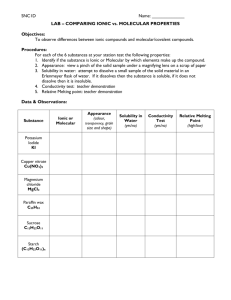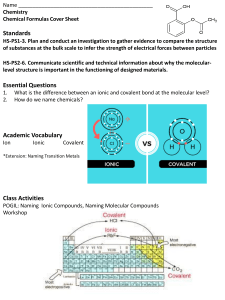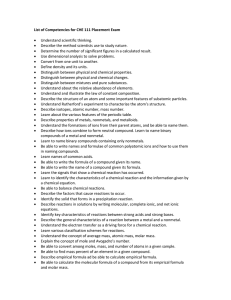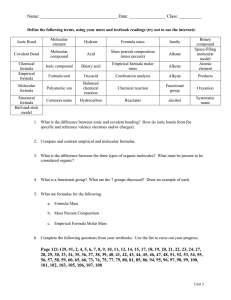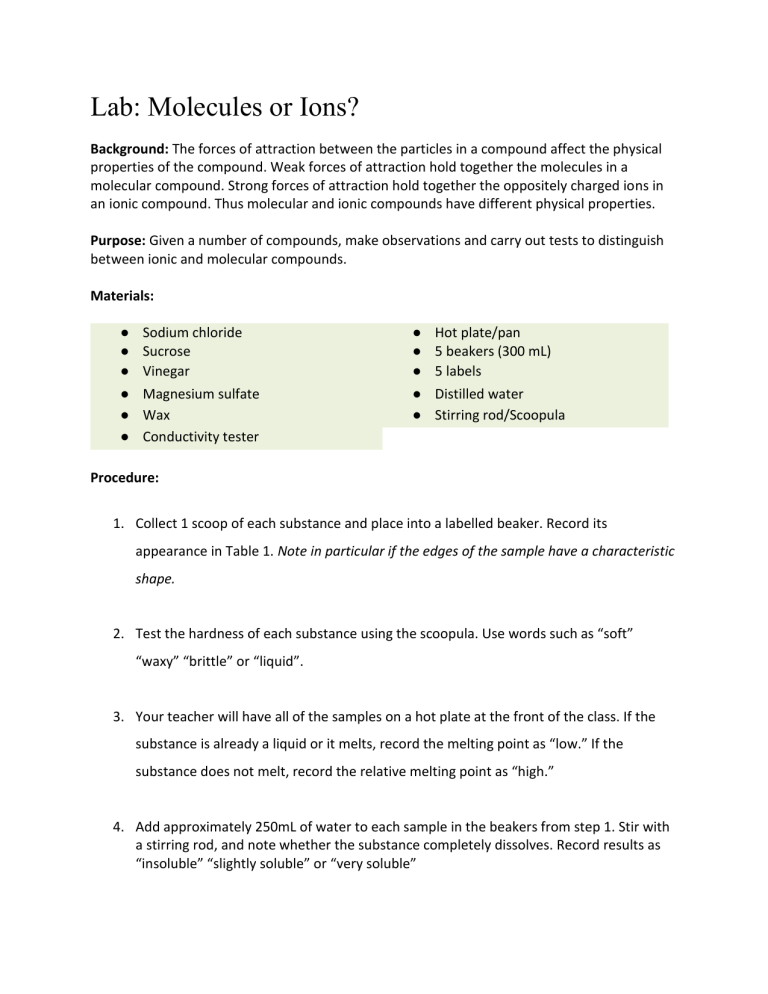
Lab: Molecules or Ions? Background: The forces of attraction between the particles in a compound affect the physical properties of the compound. Weak forces of attraction hold together the molecules in a molecular compound. Strong forces of attraction hold together the oppositely charged ions in an ionic compound. Thus molecular and ionic compounds have different physical properties. Purpose: Given a number of compounds, make observations and carry out tests to distinguish between ionic and molecular compounds. Materials: ● ● ● ● ● ● Sodium chloride Sucrose Vinegar Magnesium sulfate Wax Conductivity tester ● ● ● ● ● Hot plate/pan 5 beakers (300 mL) 5 labels Distilled water Stirring rod/Scoopula Procedure: 1. Collect 1 scoop of each substance and place into a labelled beaker. Record its appearance in Table 1. Note in particular if the edges of the sample have a characteristic shape. 2. Test the hardness of each substance using the scoopula. Use words such as “soft” “waxy” “brittle” or “liquid”. 3. Your teacher will have all of the samples on a hot plate at the front of the class. If the substance is already a liquid or it melts, record the melting point as “low.” If the substance does not melt, record the relative melting point as “high.” 4. Add approximately 250mL of water to each sample in the beakers from step 1. Stir with a stirring rod, and note whether the substance completely dissolves. Record results as “insoluble” “slightly soluble” or “very soluble” 5. Solutions of each substance are at the front of the class. Test each solution for conductivity and record your results. Record results as “conductor” “non-conductor” or “poor conductor” Record all of your data in Table 1. Observations: Table 1: Observations of 5 compounds to determine whether they are ionic or molecular Conductivity Relative Solubility in Substance Appearance Hardness in aqueous melting water solution point Sodium chloride Sucrose Vinegar Wax Magnesium sulfate Analysis: 1. Using your observations, determine whether each of the substances is an ionic or molecular compound. Write your results in Table 2. Table 2: Identify of substances (ionic or molecular) Sodium Chloride Ionic or Molecular? Sucrose Vinegar Wax Magnesium sulfate 2. Using your observation Table 1, make generalizations about the solubility, conductivity, melting points, and phases of ionic and molecular compounds. Table 3: Generalizations of Physical Properties for Ionic and Molecular Compounds Classification of Substances Solubility Conductivity Melting Point Phase at room temperature (s,l,g) Ionic Molecular 3. Explain why ionic compounds have relatively high melting points. 4. Why do molecular compounds tend not to conduct electricity? Conclusion: 1. Using the physical properties provided, determine whether the pure substance is an ionic or molecular compound: Properties of the Pure Substance A brittle solid which dissolves in water to form a colourless, non-conducting solution A substance which forms a conducting solution Ionic, or Molecular? A gas at room temperature A liquid at room temperature A solid with a high melting point A solid which does not dissolve in water A solid with a low melting point 2. Which of the following substances are probably electrolytes? Explain why? a. KBr b. AlCl3 c. C3H8 d. CS2 e. CaF2

